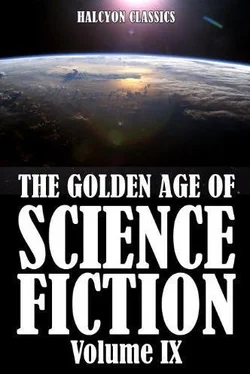This sight may be seen anywhere near the Martian equator about every ten hours.
The movements of Phobos seemed very peculiar to us who had lived upon the earth and seen all the celestial bodies appearing to move in the same direction.
I have already alluded to the fact that Phobos is only 3700 miles above the surface of Mars, and moves so rapidly that it makes more than three complete revolutions round the planet whilst the latter is turning only once on its axis.
The effect of this very rapid revolution of the satellite, which has no counterpart, so far as we know, in our Solar system is that, instead of rising in the east and setting in the west as all the other heavenly bodies appear to do, Phobos appears to rise in the west, cross the sky, and set in the east.
The moon and planets all actually move from west to east; the apparent reverse of this being caused by the more rapid movement of the earth on its axis, giving the other bodies the appearance of moving from east to west. If, however, our moon is closely watched, and its position with regard to a fixed star carefully noted, it will be found that in the course of a short time its real movement has been eastward, and that its position with regard to the fixed star has changed, although the revolution of the earth has appeared to carry both westward.
Phobos is 36 miles in diameter. Its actual period of revolution round the planet is 7 hours and 39 minutes, but, owing to the movement of Mars on its axis in the same direction, it appears to take a few minutes over 11 hours to complete one revolution.
Near the equator, Phobos is seen above the horizon for about 4-1/4 hours, and is below it about 6-3/4 hours. According as the place from which it is viewed is farther from the equator so will the time of visibility of Phobos be decreased, until when latitude 69° is reached in either hemisphere, it will cease to become visible at all. This is owing to its nearness to the planet; and, Mars being small, the curve of its sphere is sharp, so that the horizon is more limited than on the earth, and the satellite is shut out from view anywhere above latitude 69° by the body of the planet.
Another peculiarity is that, when in the zenith, Phobos appears twice as large in area as it does when near the horizon, and notwithstanding its very small size, Phobos appears rather larger than our moon, because it is so near to the planet.
The length of the Martian “night” is about 12 hours and 20 minutes, and during this very short time Phobos may be seen to rise in the west, set in the east, and rise again once more in the west. Consequently it will be evident that it must travel very rapidly across the sky. It really moves over a space of 32-1/2° in a single hour—a great contrast to the slow and stately movement of our moon, which only passes over half a degree in an hour.
Moreover, Phobos may be seen to rise as a new moon, pass through its phases to the full, wane, and again become new, all in the course of a single Martian night; or it may be seen twice full and once new during the same time.
Even this does not exhaust the list of phenomena, for, being so close to Mars, Phobos is very frequently eclipsed by the shadow of the planet. On the other hand, the sun may be eclipsed by Phobos something like fourteen hundred times in the course of a Martian year; and, as already mentioned, the other satellite is often occulted by Phobos—sometimes when both may be only at the half full phase, and these occultations look very peculiar.
Deimos, being only 10 miles in diameter and about 12,500 miles from the surface of the planet, does not give rise to so many phenomena as the nearer satellite: still they are very numerous.
It revolves round the planet in 30-1/4 hours, but appears to take 131-1/2 hours to do so, being above the horizon about 60 hours, and below it nearly 72 hours. These are the times as seen from the equator; but, as in the case of Phobos, the farther the place is from the equator the shorter is the period that Deimos is seen above the horizon, until, when latitude 82° is reached in either hemisphere, it ceases to become visible at all.
Our moon, being so very much more distant from our earth, could be seen from both the poles.
Deimos also passes nearly twice through all its phases whilst it is above the horizon, viz. during about 60 hours, and may be seen twice full and twice new in that time.
Eclipses of Deimos by the planet and occultations of it by the other satellite are very frequent. Being so small, it can never cause an eclipse of the sun, but it transits the sun as a dark spot about one hundred and twenty times during the Martian year.
This is really a very inadequate list of the phenomena connected with the satellites, but it will be seen that the number is enormous compared with the few eclipses of the sun or moon seen on the earth during the course of one year. Certainly Mars is an astronomer’s world!
Merna heard my statements respecting these movements and phenomena as I explained them to my two friends; and when I had finished, he remarked, “You seem to be fairly well posted in these matters, sir?”
“Yes,” I said; “thanks to our astronomers, both professional and amateur, all these things have been very carefully calculated; and, with the exception of a few doubtful points, we probably know nearly as much about them as the Martians themselves do.”
M’Allister then turned to me and said, “Professor, you told us that the two satellites of Mars revolved round the planet in a certain time, but in each case you afterwards said they appeared to take a much longer time to do so. I’m rather puzzled to understand how that can be.”
“It’s really a simple matter, M’Allister,” I answered, “and I think I can make it clear to you. While the satellite is making one revolution round the planet the latter is turning on its axis in the same direction as the satellite is moving, following it up in fact; and you will I think understand that in these circumstances the people on that part of the planet where the moon is visible must necessarily keep it in view for a longer period than would be the case if the planet were not revolving in the same direction.
“You have been used to being on board a ship; so suppose your vessel was steaming twelve miles an hour and there was another vessel at anchor just twelve miles ahead of you, you would reach it in just one hour, would you not?”
“Yes, certainly I should,” replied M’Allister.
“Now,” I continued, “suppose that the other vessel, instead of being at rest, was moving away from you at the rate of six miles an hour; after you had steamed one hour it would still be six miles ahead of you, and it would take you exactly another hour to catch it up. So you would be just double the time reaching it when moving as compared with the time required to do so when it was at anchor. This is very similar to the cases of the satellites of Mars, and much the same thing happens in regard to Mars and the earth. If they are opposite to each other at a certain point, Mars will have taken much more than one revolution round its orbit before they will be opposite to each other again, because they are both moving in the same direction. Do you see it now?” I asked.
“Yes, Professor,” he replied. “I know now, because you have cleared it all up. It’s simple enough when one understands it.”
Merna then asked me if I would like to see some of their astronomical instruments, and, on my replying that I should very much like to do so, he took us to an observatory where Corontus was at work.
I was at once struck by the small size of the telescopes; and, on inquiring about them, Corontus told me that very large instruments had long become obsolete, for these small ones could be used for all the purposes for which a large one had been required, and gave better results.
Читать дальше












